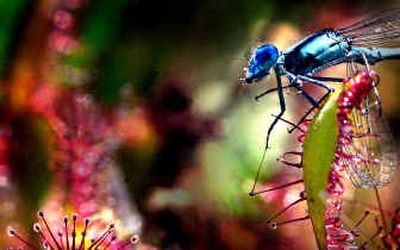Bug battle

“The enemy of my enemy is my friend” is a principle that works equally well when waging war or practicing statecraft. Farmers and gardeners are embracing the strategy, too. After all, insect invaders are everywhere.
Be advised up front that some of these biological bedfellows are creatures you may not want to pal around with. The list includes bats, wasps, snakes, spiders, toads, frogs and dragonflies, among others.
Yet, they represent the natural order of things. They can decimate the hordes of “bad bugs” and other small critters contentedly chewing their way through your garden, orchard or field.
Enlisting friendly predators can save you a bundle on sprays and insecticides if you provide the proper accommodations. Mount bat houses on poles high above the ground – 18 feet or so. Half-bury some clay pots on their sides as hideouts for slug- and bug-eating toads. Make shelters available under shed or barn eaves for the gentle paper wasps to call home. Lay a few flat pieces of wood between vegetable rows for ambush-minded wolf spiders and other nocturnal parasites to rest during the heat of day.
Dragonflies are accurately dubbed “mosquito hawks,” so invite those fearsome fliers into your yard by driving stakes into the ground to serve as perches. Provide water in places convenient to all your mercenaries.
“It’s slowly becoming more of a trend to find nonchemical ways to control things in the garden,” says David Hillock, an extension consumer horticulturist with Oklahoma State University. “But it’s hard to maintain those beneficial organisms on your property sometimes. You can release ladybugs in your yard (to kill other bugs) but there’s no way to keep them there. You can invite bats and toads but there’s no guarantee they’ll stick around, either. Getting quick and constant control of an insect problem with biologics is not always a given.”
Frank Bibin swears by the results he’s gotten after enticing bats and wasps to his family’s 27-acre organic pecan orchard near Quitman, Ga. The pairing has all but eliminated the many caterpillars and moths he discovered after acquiring Pebble Hill Grove 11 years ago.
“They basically reinforce one another,” Bibin says. “Wasps go for the larvae; bats go for the adult moths.”
Bibin recruited the helpful predators after learning the previous owner had been spraying the orchard every couple of weeks. He said he didn’t want any potentially harmful chemicals around his family.
“When we started, I wasn’t sure we’d be able to attract them,” Bibin said about the Mexican free-tailed bats. “It took about two years before they started moving in. We have about 4,000 free-tails now and a bunch of wasp nests. They’ve never bothered any of us. No one has been stung; no one has been bitten.”
And he doesn’t have a moth problem anymore.
If you’re going to do this, know friend from foe. That means being able to separate, figuratively speaking, the few venomous varieties from the mostly benign groups of predator spiders and snakes.
The two spiders to be avoided in North America are the black widow and the brown recluse. Both are poisonous and both can deliver harmful bites. Most every snake is garden-friendly except copperheads, cottonmouth moccasins, rattlesnakes and coral snakes.
Understand that even these species are good in their place, but with the threat inherent in their venom, that place isn’t underfoot. But they, like other snakes, are good at controlling populations of mice and moles.
“You’ve got to be patient,” Hillock says. “Give the beneficial insects and biologic controls time to do their thing. Some people can tolerate a little insect damage; some can’t take any at all. Some people wait longer than others before going after chemicals.
“If biology doesn’t work, and you might lose all your plants, then it’s probably time to reach for a pesticide. But integrated plant management is a system that recommends using all your benign resources before using the sprays.”